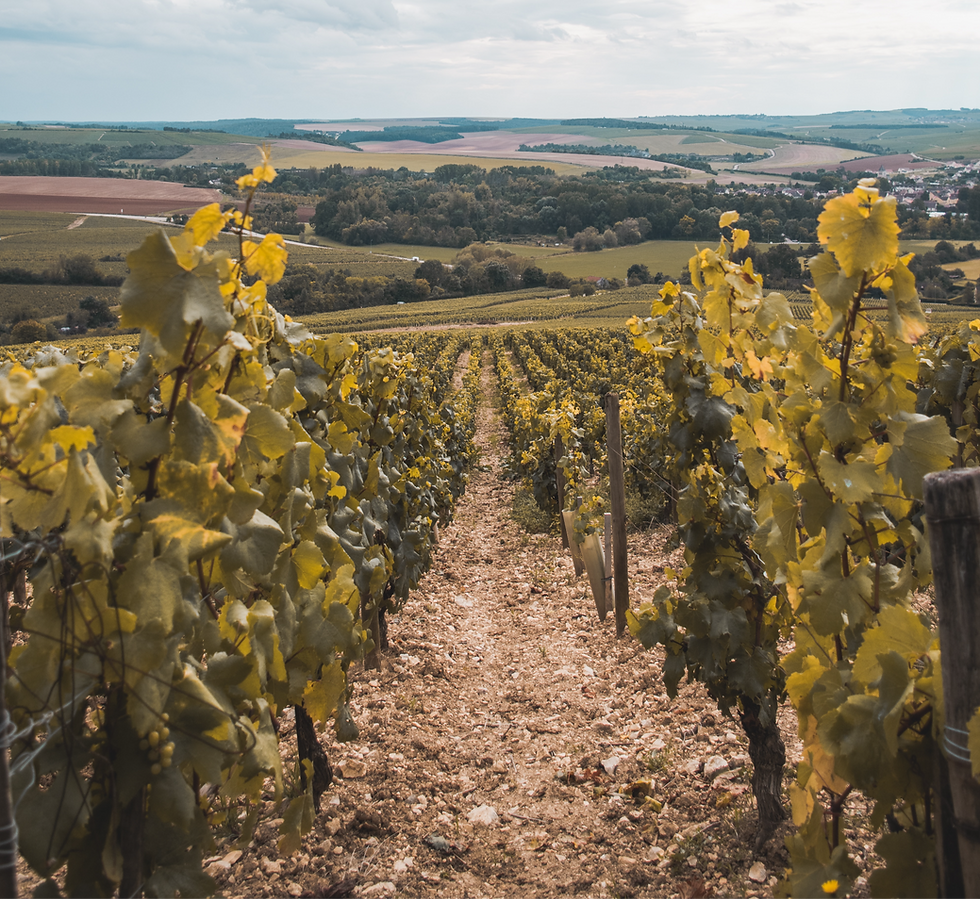Chardonnay from Essex way?
- Lewis MacDonald
- Sep 1
- 4 min read
Updated: Sep 8
This July, a prolonged period of dry and stunningly hot weather had encouraged me out into the garden. There I spent a few days chopping down an old dead lilac tree and getting thoroughly sun burnt! It was during this bit of DIY landscaping that I found myself in need of a set of tools from the local Garden Centre. Here my focus immediately shifted from spade to wine. My eye caught an inviting, and altogether intriguing bottle of British chardonnay from Lyme Bay Winery near Axminster in Devon.

Why was this white wine so fascinating to me you might ask?
Well the thing is, according to traditional viticultural teachings, there is no such thing as a cold climate chardonnay. Whilst the previous few weeks had us Brits sweltering in 30+ degrees and turning a brighter shade of red than ripe Hereford strawberries, England is meant to be a cold climate, at least according to how winemakers classify the weather.
Chardonnay is a grape that loves a ‘cool climate’ but can’t stand a ‘cold’ one. Let me give you an example.
Chablis, a climate on the edge

The famous chardonnay heartland of Chablis in France is classified as a ‘Cool Climate’ for grape growing. The region itself is landlocked but still occasionally feels the very edges of oceanic weather patterns spreading their way down from the English Channel. This formulates Chablis’ so called semi-continental climate, a year punctuated by harsh cold frosts in the winter, and warm extended summers with year-round moderate rainfall.
This climate can therefore be a bit of a gamble for producing great chardonnay. Cold starts to spring can damage early budding vines, significant rainfall can encourage the spread of devastating fungal disease and if the summer proves not as hot during a particular vintage, yields can be vanishingly small for some producers.
You might question why anyone would attempt to grow grapes in a region with such risks, but that’s when we need to talk acidity.
Chardonnay is a grape that holds a lot of potential based upon its growing conditions. A ‘Cool Climate’ can instil in this little grape some mouth-wateringly dry acidity with vibrant citrus notes and a strong mineral character on which to wrap its body. Therefore, it is arguable that growing chardonnay here where the climate is just on the verge of being too cold can produce the best, most complex dry and expensive white wine in the world. Certainly, the high price of a Grand Cru Chablis would prove this argument true.
Where does this leave England for the potential for growing a decent chardonnay, or any chardonnay at all?
England, too cool for school

England, specifically Essex from where Lyme Bay’s chardonnay sourced its grapes, is considered oceanic in climate. That means that the nearby English Channel and North Sea have significant impacts on the weather. During the summer, cold Nordic breezes ensure that summer temperatures rarely reach the extreme average heights of the Chablis region. During winter the Gulf Stream funnels milder weather from the South Pacific preventing the extreme cold snaps that can threaten early budding vines.
So far so Good?
Well not entirely. These two competing weather fronts often meet in the middle and bring Britain a continual stream of grey drizzly weather. The constant rainfall causes two problems for anyone attempting to grow grapes. Firstly, the best wine comes from vines that are only sparsely watered. A thirsty vine creates grapes with less water content and therefore more intensely flavoured. Moreover, a vine in saturated ground is at risk of losing its roots to rot. This means that England’s famously wet weather should be a major roadblock for any aspiring viticulturalist.
To add to this the moderating effects of the North Sea have generally ensured that British summers never reach the high temperatures found in Chablis, and whilst chardonnay likes a ‘Cool Climate’ that climate must still achieve a high enough temperature in summer to help fully ripen the grapes. Without the warmth you end up with semi-ripened fruits filled with acidity and nowhere near enough sugar. The resultant ‘wine’ (if you can even call it that) will be painfully sharp, lacking in depth and most worryingly, far too low in alcohol!
Global Warming to the rescue?
This is where we hit a point of climactic divergence, however. Global warming is real and is already impacting the British climate in significant ways. In the last few years, the average temperature of the British summer is now regularly reaching well above 30 degrees, with rainfall becoming so irregular that every year we are threatened with a nationwide hosepipe ban. Whilst this might be an uncomfortable truth for the average Brit, for our winegrowers it has brought us a bit of a golden age. The last decade has seen summers not unlike those experienced in the Champagne region north of Chablis. It is partly our warming weather that has brought the rise of English Sparkling wine that is now winning awards and arguably surpassing its French competition.

Rather promisingly, Lyme Bay Winery shows us that the warming weather means we can expect to see more chardonnay made in the UK that can rival that of Chablis.
To find out more about this specific chardonnay, keep an eye out for my next post reviewing Lyme Bay Winery's 2022 vintage.

Comments